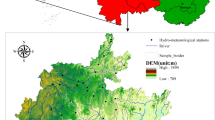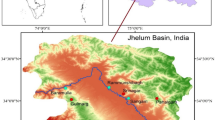Abstract
The relationship between rainfall and runoff in the Wei River Basin, one of the most important relationships in hydrology, possibly changed due to the changing climate and increasingly intensifying human activities. The identification of abrupt changes of the relationship will help to further understand the changing mechanism of runoff generation, being a great stimulus to the development of water resources planning and management. Therefore, a new method based on copulas was employed to detect change points of the relationship. Additionally, a Bayesian copula selection method was employed to choose the most appropriate copula, and the primary conclusions are as follows:(1) the Bayesian copula selection method based on Bayesian analysis is independent of parameter selections and easy to implement; (2) the identified change points can be summarized as the early 1970s, the late 1980s, and the middle 1990s; (3) from climate change perspective, the combined impact of increasing air temperature and initially decreasing then increasing potential evaporation had a certain effect on these change points; from human activities perspective, the underlying causes of these change points of the early 1970s, the late 1980s, and the middle 1990s were the construction of water projects and soil conservation, the growing effective arable land of the late 1980s and the growing utilization of water resources in the middle 1990s, respectively. The dominant factor influencing the relation between precipitation and runoff is the increasingly intensifying human activities, and this relation is increasingly weakening.






Similar content being viewed by others
References
Allen RG, Pereira LS, Raes D, Smith M (1998) Crop evapotranspiration guidelines for computing crop water requirements. FAO irrigation and drainage paper no. 56. FAO, Rome
Bi CX, Mu XM, Zhao GJ et al (2013) Effects of climate change and human activity on streamflow in the Wei River Basin. Sci Soil Water Conserv 11(2):33–38 (In Chinese)
David H, Guillaume É, Anne-Catherine F (2006) Bayesian copula selection. Comput Stat Data Anal 51:809–822
Demarta S, McNeil AJ (2005) The t copula and related copulas. Int Stat Rev 73(1):111–129
Dias A (2004) Copula inference for finance and insurance. Doctoral thesis, ETH
Dijk AIJM, Bruijnzeel LA, Rosewell CJ (2002) Rainfall intensity-kinetic energy relationships: a critical literature appraisal. J Hydrol 261:1–23
Dong YH, Wang ZH, Chen ZY, Yin DW (2009) Centennial fluctuations of flood season discharge of upper and middle Yangtze River basin, China (1865–1988): cause and impact. Front Earth Sci China 3(4):471–479
Gao JB, Gunn SR et al (2001) A probabilistic framework for SVM regression and error bar estimation. Mach Learn 46:71–89
Genest C, Rivest L (1993) Statistical inference procedures for bivariate Archimedean copulas. J Am Stat Assoc 88(424):1034–1043
Hao LJ (2004) Analysis on variation and influencing factors of relationship between rainfall and runoff in Miyun Reservoir watershed. Beijing Water Res 3:41–43
He WL, Xu ZX (2006) Spatial and temporal characteristics of the long-term trend for temperature and pan evaporation in the Wei River basin. J Beijing Norm Univ (Nat Sci) 42(1):102–106
Huang Q, Fan JJ (2013) Detecting runoff variation of the mainstream in Weihe River. J Appl Math. doi:10.1155/2013/356474
Hyosang L, Neil M et al (2005) Selection of conceptual models for regionalization of the rainfall-runoff relationship. J Hydrol 312:125–147
IPCC (2007) Climate change 2007: the physical science basis. Summary for policymakers. In: IPCC WGI Fourth Assessment Report, Paris
Kao SC, Govindaraju RS (2010) A copula-based joint deficit index for droughts. J Hydrol 380:121–134
Karamouz M, Ahmadi A, Moridi A (2009) Probabilistic reservoir operation using Bayesian stochastic model and support vector machine. Adv Water Resour Manag 32(11):1588–1600
Kinnell PIA (2005) Raindrop-impact-induced erosion processes and prediction: a review. Hydrol Process 19:2815–2844
Lin SW, Ying KC, Chen SC et al (2008) Particle swarm optimization for parameter determination and feature selection of support vector machines. Expert Syst Appl 35(4):1817–1824
Mathier L, Perreault L, Bobe B (1992) The use of geometric and gamma-related distributions for frequency analysis of water deficit. Stoch Hydrol Hydraul 6(4):239–254
Meek TH, Meek LA (2009) Increasing inequality is already making shortages worse. Nature 459:31. doi:10.1038/459031b
Palynchuk DA, Guo Y (2011) A probabilistic description of rain storms incorporating peak intensities. J Hydrol 409:71–80
Rodriguez JC (2007) Measuring financial contagion: a Copula approach. J Empir Finan 14:401–423
Rodriguez-Iturbe I (2000) Ecohydrology: a hydrologic perspective of climate–soil–vegetation dynamics. Water Resour Res 36(1):3–9
Rodríguez-Iturbe I, Porporato A (2004) Ecohydrology of water-controlled ecosystems: soil moisture and plant dynamics. Cambridge University Presses, Cambridge
Shaanxi statistical yearbook (2000) China statistical publishing house. (In Chinese)
Shaanxi statistical yearbook (2010) China statistical publishing house. (In Chinese)
Sharma PP, Gupta SC, Foster GR (1993) Predicting soil detachment by raindrops. Soil Sci Soc Am J 57:674–680
Shi CX, Zhou YY, Fan XL et al (2012) A study on the annual runoff change and its relationship with water and soil conservation practices and climate change in the middle Yellow River basin. Catena 100:31–41
Shiau JT (2006) Fitting drought duration and severity with two-dimensional Copulas. Water Resour Manag 20:795–815
Taner M, Carleton JN, Wellman M (2011) Integrated model projections of climate change impacts on a North American lake. Ecol Model 222(18):3380–3393
Vapnik V (1995) The nature of statistical learning theory. Springer Verlag, New York
Vapnik VN (1998) Statistical learning theory. Wiley, New York
Wang XJ, Gebremichael M, Yan J (2010) Weighted likelihood copula modeling of extreme rainfall events in Connecticut. J Hydrol 390:108–115
Wei W, Chen LD et al (2007) The effect of land uses and rainfall regimes on runoff and soil erosion in the semi-arid loess hilly area, China. J Hydrol 335:247–258
Wilks DS (1999) Interannual variability and extreme-value characteristics of several stochastic daily precipitation models. Agric For Meteorol 93:153–169
Yan Y, Yang ZF et al (2013) Nonlinear trend in streamflow and its response to climate change under complex ecohydrological patterns in the Yellow River Basin, China. Ecol Model 252:220–227
Zhang SR, Lu XX (2009) Hydrological responses to precipitation variation and diverse human activities in a mountainous tributary of the lower Xijiang, China. Catena 77:130–142
Zhang H, Chen Y, Ren G, Yang G (2008) The characteristics of precipitation variation of Weihe River Basin in Shaanxi Province during recent 50 years. Agric Res Arid Areas 26(4):236–242 (In Chinese)
Zhang Q, Xu CY et al (2009) Abrupt behaviors of the streamflow of the Pearl River basin and implications for hydrological alterations across the Pearl River Delta, China. J Hydrol 377:274–283
Zhang ZG, Chen X et al (2011) Evaluating the non-stationary relationship between precipitation and streamflow in nine major basins of China during the past 50 years. J Hydrol 409:81–93
Zhang Q, Singh VP, Peng JT et al (2012) Spatial–temporal changes of precipitation structure across the Pearl River basin, China. J Hydrol 440–441:113–122
Acknowledgments
This research was supported by the Natural Science Foundation of China (51190093, 51179149, 51179149), the National Major Fundamental Research Program, 973 (2011CB403306), the Ministry of Education in the new century talents program (NCET-10-0933), the Key Innovation Group of Science and Technology of Shaanxi (2012KCT-10), and the Ministry of Water Resources Public Welfare Special Industry Research (201101043, 201101049). Sincere gratitude is extended to the editor and anonymous reviewers for their professional comments and corrections, which greatly improved the presentation of the paper.
Author information
Authors and Affiliations
Corresponding authors
Rights and permissions
About this article
Cite this article
Huang, S., Chang, J., Huang, Q. et al. Identification of abrupt changes of the relationship between rainfall and runoff in the Wei River Basin, China. Theor Appl Climatol 120, 299–310 (2015). https://doi.org/10.1007/s00704-014-1170-7
Received:
Accepted:
Published:
Issue Date:
DOI: https://doi.org/10.1007/s00704-014-1170-7




